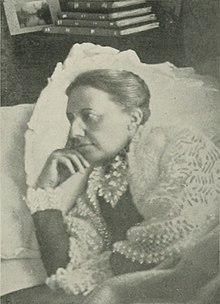Lisa Anne Fletcher (née, Stewart; December 27, 1844 – July 13, 1905) was an American poet and letter writer.[1] She was widely known as artist, poet and correspondent. She was incapacitated for nearly 40 years by the lasting effects of malignant diphtheria, and during most of that period was bedridden, becoming a member of the Shut-in Society in 1878.[2]
Lisa Anne Fletcher | |
|---|---|
 | |
| Born | Lisa Anne Stewart December 27, 1844 Ashby, Massachusetts, U.S. |
| Died | July 13, 1905 Manchester, New Hampshire, U.S. |
| Nickname | "Lizzie" |
| Occupation |
|
| Genre | letter writing |
| Literary movement | Shut-in Society |
| Spouse |
Edwin Samuel Fletcher
(m. 1864) |
Early life
editLisa (nickname, "Lizzie") Anne Stewart was born in Ashby, Massachusetts, December 27, 1844.[1] Her parents were Charles Stewart and Eliza (Derby) Stewart.[3] When she was two years old, her father died, and when she was 16, her mother died. She was an only child. From earliest childhood, she showed an almost equal fondness for music, painting and poetry.[1]
Career
editIn 1865, at the age of 20, the newly-wed Fletcher, now living in Manchester, New Hampshire, contracted diphtheria in its most severe form. In her later years, she was bedridden, and worked in a reclining position. She kept a large correspondence, partly through the Shut-in Society. She wrote thousands of letters,[4] and fulfilled the Society's mission of offering cheer and comfort to others.[1] In later years, she was a member of the Tribune sunshine society, to which she contributed in similar fashion.[2]
In June, 1888, Fletcher began to write verse in earnest,[1] mostly descriptive of objects and aspects in nature. Her poems' spirit of cheerfulness and hopefulness appealed to thousands who knew nothing of Fletcher's own story, and which appeared amazing to those who knew it in a general way, but did not understand the sources from which her cheerfulness and contentment sprang. Many of her poems were collected in a volume entitled Beside Still Waters, while many others remained fugitive. She contributed regularly to more than 30 newspapers and magazines.[2]
Fletcher painted a collection of wildflowers that grew about Manchester, New Hampshire.[1] The collection represented more than 300 species and was frequently exhibited. Many of the works had a place in the World's Columbian Exposition (Chicago, 1893).[2]
Stewart's love for birds amounted to a passion. From her chair, she studied the wild birds outside her window and sketched and painted them.[4] She was a local secretary of the Audubon Society.[1] Fletcher conducted a wide correspondence with nature lovers, and bird lovers in particular.[2]
Personal life
editIn 1864, she married Edwin Samuel Fletcher (1883–1923),[3] of Manchester, since which time her home was in that city.[1]
Lisa Anne Fletcher died in Manchester, New Hampshire, July 13, 1905.[2]
Selected works
edit- Beside Still Waters (New York, Anson D.F. Randolph & Company, 1899)[5]
References
edit- ^ a b c d e f g h Willard, Frances Elizabeth; Livermore, Mary Ashton Rice (1893). "FLETCHER, Mrs. Lisa Anne". A Woman of the Century: Fourteen Hundred-seventy Biographical Sketches Accompanied by Portraits of Leading American Women in All Walks of Life. Charles Wells Moulton. p. 293. This article incorporates text from this source, which is in the public domain.
- ^ a b c d e f "Obituary, Lisa Anne Fletcher. Died July 13, 1905, Manchester, New Hampshire". The Boston Globe. July 15, 1905. p. 10. Retrieved December 11, 2022 – via Newspapers.com. This article incorporates text from this source, which is in the public domain.
- ^ a b "Lisa Anne Stewart 27 December 1844 – 13 July 1905 • KVSY-B74". www.familysearch.org. Retrieved December 11, 2022.
- ^ a b Marshall, Mary (December 27, 1915). "Noted Women". The Standard Union. p. 10. Retrieved December 11, 2022 – via Newspapers.com. This article incorporates text from this source, which is in the public domain.
- ^ "NEW PUBLICATIONS". The Evangelist. LXX (50). New York: Henry M. Field: 26. December 14, 1899. Retrieved December 11, 2022.
External links
edit- Works related to Woman of the Century/Lisa Anne Fletcher at Wikisource
- Works by or about Lisa Anne Fletcher at the Internet Archive